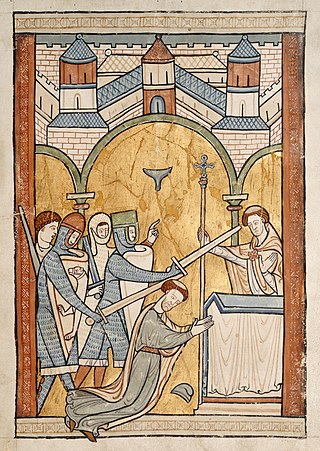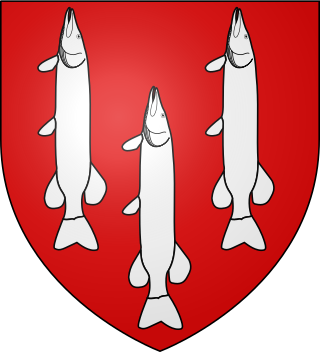
Henry, 3rd Earl of Leicester and Lancaster was a grandson of King Henry III of England (1216–1272) and was one of the principals behind the deposition of King Edward II (1307–1327), his first cousin.

The Lord High Constable is a hereditary, now ceremonial, office of Scotland. In the order of precedence of Scotland, the office traditionally ranks above all titles except those of the royal family. The Lord High Constable was, after the King of Scots, the supreme officer of the Scottish army. He also performed judicial functions as the chief judge of the High Court of Constabulary. From the late 13th Century the Court – presided over by the Lord High Constable or his deputies – was empowered to judge all cases of rioting, disorder, bloodshed and murder if such crimes occurred within four miles of the King, the King's Council, or the Parliament of Scotland. Following James VI's move to England, the jurisdiction of the Lord High Constable was defined in terms of the "resident place" appointed for the Council.
Lochlann of Galloway, also known as Lochlan mac Uchtred and by his French name Roland fitz Uhtred, was the son and successor of Uchtred, Lord of Galloway as the "Lord" or "sub-king" of eastern Galloway.

de Lacy is the surname of an old Norman family which originated from Lassy, Calvados. The family took part in the Norman Conquest of England and the later Norman invasion of Ireland. The name is first recorded for Hugh de Lacy (1020–1085). His sons, Walter and Ilbert, left Normandy and travelled to England with William the Conqueror. The awards of land by the Conqueror to the de Lacy sons led to two distinct branches of the family: the northern branch, centred on Blackburnshire and west Yorkshire was held by Ilbert's descendants; the southern branch of Marcher Lords, centred on Herefordshire and Shropshire, was held by Walter's descendants.

Alan fitz Walter was hereditary High Steward of Scotland and a crusader.
Hugh de Morville of Appleby in Westmorland, England, hereditary Constable of Scotland, was a Norman knight who made his fortune in the service of David FitzMalcolm (d.1153), Prince of the Cumbrians, later King of Scotland.
Richard de Morville, Lord of Cunninghame succeeded his father, Hugh de Morville, as Constable of Scotland and in his Scottish estates and English lands at Bozeat in Northamptonshire, and Rutland, as well as a number of feus of the Honour of Huntingdon.

Sir Hugh de Morville was an Anglo-Norman knight who served King Henry II of England in the late 12th century. He is chiefly famous as one of the assassins of Thomas Becket, Archbishop of Canterbury in 1170. He held the title Lord of Westmorland and of Knaresborough; his father was Hugh de Morville, Constable of Scotland.

Walter de Lacy was lord of Meath in Ireland. He was also a substantial land owner in Weobley, Herefordshire, in Ludlow, Shropshire, in Ewyas Lacy in the Welsh Marches, and several lands in Normandy. He was the eldest son of Hugh de Lacy, a leading Cambro-Norman baron in the Norman invasion of Ireland, and Rohese of Monmouth.

Hugh de Balliol, Lord of Bywell, Barnard Castle and Gainford, was an English nobleman. He was the son of Eustace de Balliol and Petronilla FitzPiers. Balliol was a supporter of King John of England during the Barons Wars of 1215–17.
Sir Thomas Moulton was an English landowner, knight, admiral and judge during the reigns of King John and King Henry III. From a family with landholdings in the south of Lincolnshire, he was the son and heir of Thomas Moulton and his wife Eleanor Boston. After initial military service, he became a senior judge and held important government positions, in the process extending his inherited estates and accumulating considerable wealth.
Egidia de Lacy, Lady of Connacht, was a Cambro-Norman noblewoman, the wife of Richard Mór de Burgh, 1st Baron of Connaught and Strathearn (c.1180–1242), and the mother of his seven children, including Sir William Óg de Burgh, a lord and warrior and Walter de Burgh, the first Earl of Ulster. She was also known as Gille de Lacy. Egidia was the daughter of Walter II de Lacy by his second wife Margaret de Braose.
Hugh de Morville may refer to:
Margaret of Huntingdon was a Scottish princess and Duchess of Brittany. She was the sister of Scottish kings Malcolm IV and William I, wife of Conan IV, Duke of Brittany, and the mother of Constance, Duchess of Brittany. Her second husband was Humphrey de Bohun, hereditary Constable of England. Following her second marriage, Margaret styled herself as the Countess of Hereford.
Robert III de Stuteville was an English baron and justiciar.
William de Lancaster I, or William Fitz Gilbert, was a nobleman of the 12th century in Northwest England during the Anarchy, and the period during which his region was ruled by King David I of Scotland. His position survived the return of English rule under King Henry II, and his most important lordship, which had previously come together under Ivo de Taillebois, would evolve into what was eventually known as the barony of Kendal. According to a document some generations later, he was also referred to as William de Tailboys when younger, and then became "William de Lancaster, baron of Kendal". He died in about 1170.

Robert de Vieuxpont, also called Vipont, Veteripont, or de Vetere Ponte, Baron of Westmorland, was an Anglo-Norman noble landowner and administrator.

Richard de Luci, sometimes spelt Lucy, Baron of Egremont and Copeland, was an English noble.

William de Greystoke, sometimes known as William FitzRanulf, Baron of Greystoke, was an English noble.
William de Stuteville Baron of Cottingham in the East Riding of Yorkshire, Lord of Buttercrambe in the North Riding of Yorkshire, was an English noble.








